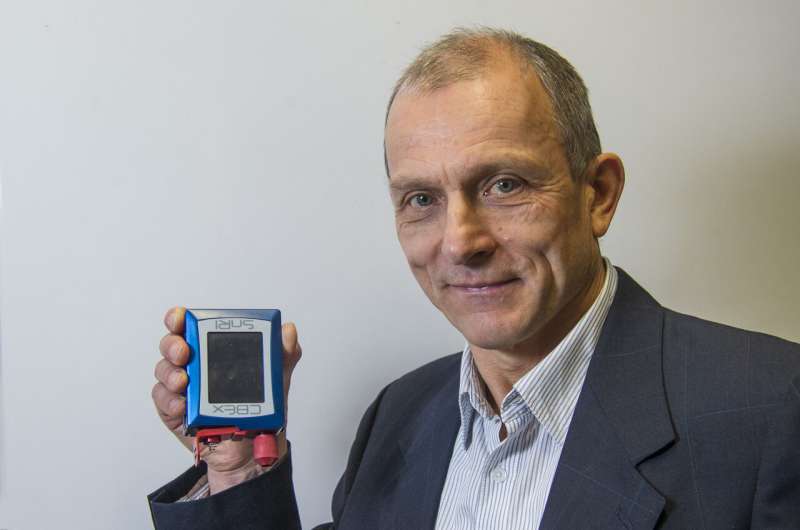Igor Lednev holds a prototype of a scanner that can be used by law enforcement to analyze biological stains at crime scenes. Credit: University at Albany
New research published by forensic chemist Igor Lednev could soon offer law enforcement another valuable crime scene tool—a quick and accurate way to distinguish human blood from animal blood.
In a proof-of-concept study, Lednev, a professor in the University at Albany's Department of Chemistry, and Ewelina Mistek-Morabito, a doctoral chemistry student in his lab, used laser technology to rapidly differentiate human blood samples from nearly a dozen animal species.
This could prove to be key in car crash investigations when the suspect is unsure if a human or animal was struck. For example, South Dakota Attorney General Jason Ravnsborg recently drew national attention when he told authorities he thought he hit a deer, not realizing he'd actually hit and killed a pedestrian.
"Most current techniques used for discrimination between human and animal blood cannot be done at the crime scene and also result in destruction of the sample," said Lednev. "We instead can offer a non-destructive way to test traces of blood left behind on a suspect's car bumper that will answer the question of its origin immediately."
Laser Forensics
Lednev's technique relies on Raman spectroscopy, which works by shining a laser on a dry blood sample and measuring the interaction. No two samples produce the same results, offering a unique measurement (similar to a fingerprint). The results are instantaneous and do not destroy the sample, preserving it for future testing.
In the new study, the Lednev lab used attenuated total reflection Fourier transform-infrared (ATR FT-IR) spectroscopy, a complementary technique to Raman spectroscopy, on 15 human blood samples and a total of 89 cat, dog, rabbit, horse, cow, pig, opossum and raccoon blood samples. Although each sample appeared nearly identical to the naked eye, the ATR FT-IR spectroscopy analysis, coupled with advanced statistics, was able to classify them as human or animal with 100 percent accuracy.
Samples from three other species—deer, elk and ferret—were included to further test the statistical model, and were all correctly classified.
Results were published this month in Communications Chemistry.
"When testing blood samples, the general composition is very similar," said Mistek-Morabito, the study's lead author. "We were very excited to discover that our ATR FT-IR spectroscopy technique was sensitive enough to detect the minor discrepancies and could successfully differentiate between human and animal blood."
"Now that our research has shown strong results in a lab setting, we must next validate it using true crime scene conditions," she added.
Lednev and his team have pioneered the use of Raman spectroscopy for forensics purposes over the last decade. In previous studies, they identified a number of key characteristics based on common physical evidence found at a crime scene (such as blood, saliva and sweat) including the type of body fluid, time since deposition, the race, sex and age group of the donor, and if the donor is a smoker.
They're now in collaboration with Ray Wickenheiser, director of the New York State Police Crime Lab System, to turn these discoveries into a single, portable instrument that can assist criminal investigations.
More information: Ewelina Mistek-Morabito et al. Discrimination between human and animal blood by attenuated total reflection Fourier transform-infrared spectroscopy, Communications Chemistry (2020). DOI: 10.1038/s42004-020-00424-8
Provided by University at Albany






















